


Violent burning of acetylene in chlorine
It is well-known that acetylene gas burns exceptionally well and it easily makes explosive mixtures with air. This property is used in an old Dutch folklore called 'carbid schieten'. Very loud bangs of exploding air/acetylene mixtures are produced on New Year's eve.
In this experiment, it is shown, that making explosions with acetylene is even easier when chlorine gas is used instead of air. There is no need to ignite the mix of gasses. Simply leading of acetylene gas into chlorine leads to violent burning or even exploding of the gas mixture. A lot of soot is produced in this reaction. This is a spectacular experiment, very suitable for a demonstration, but it should not be scaled up to sizes, larger than indicated here.
![]()
![]() This
experiment uses chlorine gas extensively. It should be conducted in a good fume
hood or outside. Do not attempt to do this in a poorly ventilated room!
This
experiment uses chlorine gas extensively. It should be conducted in a good fume
hood or outside. Do not attempt to do this in a poorly ventilated room!
![]()
![]() Required
chemicals:
Required
chemicals:
-
chlorine gas (or dilute HCl + calcium chloride, bleach or TCCA for swimming pools)
-
acetylene gas (or water + technical calcium carbide)
![]() Required
equipment:
Required
equipment:
-
large erlenmeyer or glass beaker, 250 to 500 ml
- large tub for holding water
- syringe of approximately 50 ml + small plastic tube
![]() Safety:
Safety:
- chlorine gas is very toxic and corrosive. Avoid breathing this gas.
- acetylene gas is extremely flammable and forms explosive mixtures with air over a large range of concentrations.
![]() Disposal:
Disposal:
- Any excess chlorine gas, not used in this experiment can be released in the air, outside or in a good fume hood.
- Any excess acetylene gas can be released in the air.
- The stains of soot in the tub and erlenmeyer can best be removed, by first removing water with a dry paper tissue, and then cleaning with a tissue, soaked with white spirit or ligroin.
![]()
Setting up the experiment
A syringe and a fairly large erlenmeyer are needed in this experiment. The picture shows a 60 ml syringe, and a 300 ml erlenmeyer. Other sizes of course can be used, but the size should be of the same order of magnitude.

![]() The
syringe must be filled with acetylene gas. In this experiment this was done by
reacting technical calcium carbide (also known as 'carbid') with water and
soaking the gas into the syringe. It is very important that the acetylene gas
is not mixed with air, otherwise the syringe may explode during this experiment.
A safe way of preparing the gas is immersing a beaker of 100 ml upside down
under water, with no air in the beaker. Then put a piece of calcium carbide
under the beaker and collect the gas. Next, take the syringe with a short
plastic tube and suck the gas into the syringe. Keep the tip of the syringe
closed, or keep it under water, such that no air can go in.
The
syringe must be filled with acetylene gas. In this experiment this was done by
reacting technical calcium carbide (also known as 'carbid') with water and
soaking the gas into the syringe. It is very important that the acetylene gas
is not mixed with air, otherwise the syringe may explode during this experiment.
A safe way of preparing the gas is immersing a beaker of 100 ml upside down
under water, with no air in the beaker. Then put a piece of calcium carbide
under the beaker and collect the gas. Next, take the syringe with a short
plastic tube and suck the gas into the syringe. Keep the tip of the syringe
closed, or keep it under water, such that no air can go in.
![]() Approximately 100 ml of chlorine gas is needed in this
experiment. The gas need not be very pure, when it still contains some air, then
that is not a real concern. The chlorine gas can best be prepared by adding
approximately 1000 mg of calcium hypochlorite to approximately 10 ml of dilute
hydrochloric acid (appr. 10% HCl by weight). This must be done in a bottle of
100 ml. The chlorine gas then must be bubbled into the large erlenmeyer of 250
to 500 ml, which already is kept upside down, in a tub, filled with water.
Approximately 100 ml of chlorine gas is needed in this
experiment. The gas need not be very pure, when it still contains some air, then
that is not a real concern. The chlorine gas can best be prepared by adding
approximately 1000 mg of calcium hypochlorite to approximately 10 ml of dilute
hydrochloric acid (appr. 10% HCl by weight). This must be done in a bottle of
100 ml. The chlorine gas then must be bubbled into the large erlenmeyer of 250
to 500 ml, which already is kept upside down, in a tub, filled with water.
The picture below shows the wiring, needed for the experiment.

Of course, in the real experiment, the erlenmeyer is partially filled with chlorine gas, and the tub is filled with water. In the following picture, the initial situation is shown, with the chlorine in the erlenmeyer, and the syringe, filled with acetylene gas in the hands, ready to press the gas into the erlenmeyer.

![]()
The experiment: Flashes and flames in the erlenmeyer
When acetylene gas is bubbled into the erlenmeyer, then as soon as the gas reaches the surface and comes into contact with the chlorine, a bright flash occurs and a lot of soot is produced. Below follow a few pictures of such a reaction, when the first bubble of gas is pressed into the erlenmeyer.
The left picture shows the erlenmeyer with chlorine gas, just before the bubble of acetylene gas reaches the surface. The right picture shows the spontaneous ignition of the bubble of acetylene. It reacts with the chlorine, giving a lot of light and a WHOOMP sound.
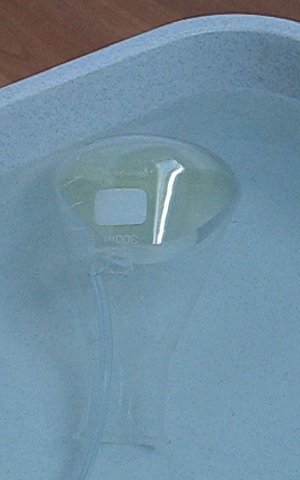
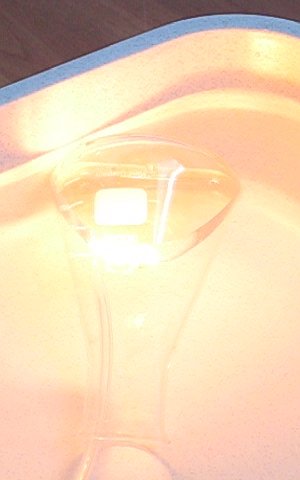
The flash only lasts for a short time. Quickly after the flash, the remains of the gas burn with a deep orange/red flame and a lot of soot is produced. Around the flame, black rims of soot can be observed. This soot is responsible for the intense light in the initial flash. The soot initially is very hot, but on cooling down, it gives the orange/red light. Especially the right picture very nicely shows the dark rim of soot around the flame.
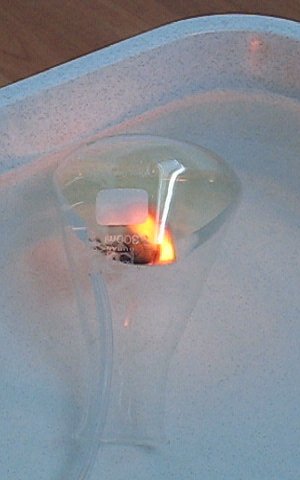
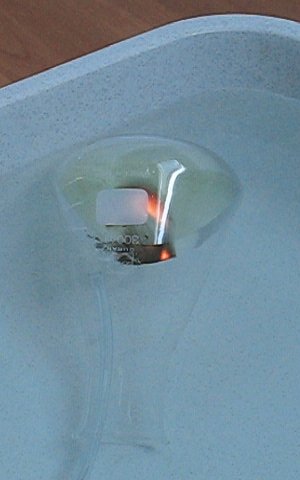
Finally, when the acetylene gas has reacted, the soot moves upwards. The gas-mixtures, carrying the soot still is hot and hence it moves upwards in the chlorine gas and the cloud of soot remains stuck in the highest part of the erlenmeyer. Another amount of soot remains floating on the surface, and also sticks to the glass.
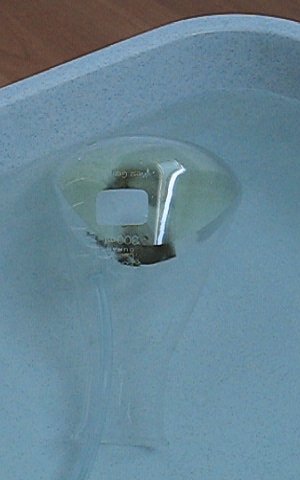
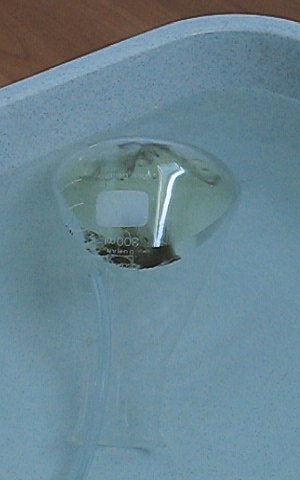
When a larger bubble of acetylene gas is pressed into the chlorine gas, then a violent reaction occurs. This reaction can be so violent, that the erlenmeyer is almost blown out of the water and the gas mix partially is swirled out of the erlenmeyer. The result of this larger explosion is shown in the pictures below.
The top-left picture shows the erlenmeyer, in which there have been already quite a few smaller explosions (the chlorine gas looks black now, with black soot finely divided in the chlorine gas). In this gas, quite a large amount (10 ml or so) of acetylene gas was pressed. Initially, no reaction occurred, but after a short elay (a second or so) it suddenly exploded. The explosion was so violent, that a lot of water was sprayed around, and the resulting waves were so strong, that the water just did not go over the rim of the tub. The small pictures show the explosion itself (with 33 ms between two frames), the larger two pictures below nicely show how violently the water is moved around after the explosion.
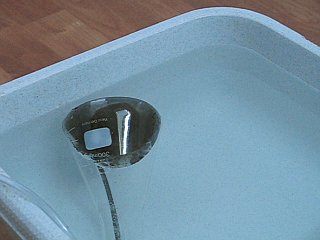
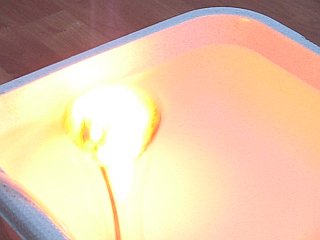
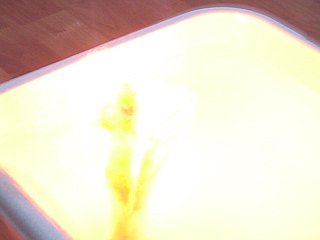
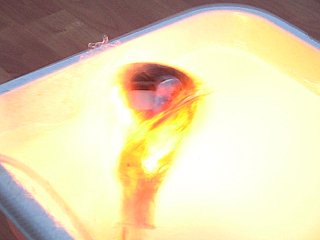
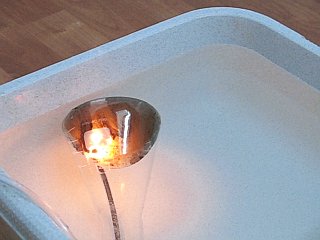
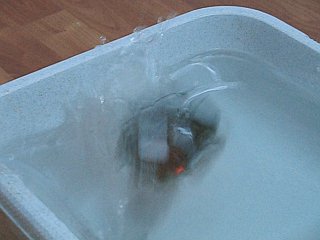
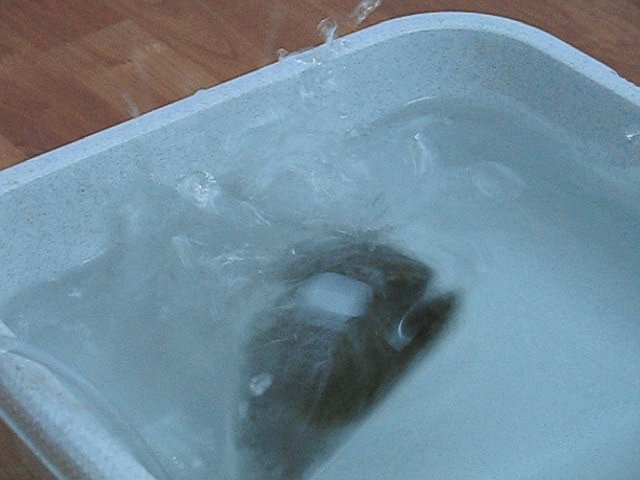
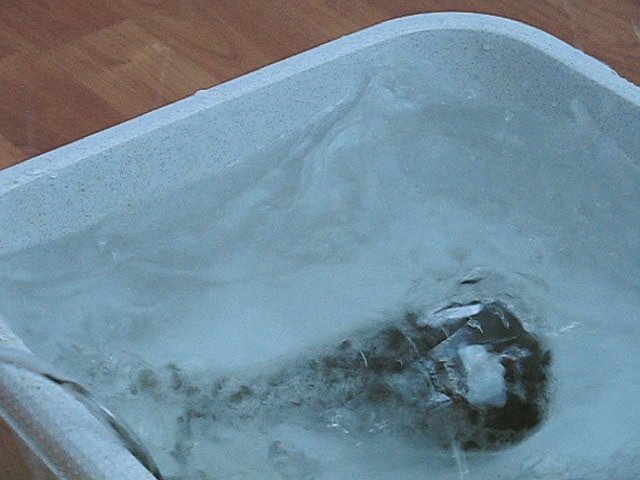
The erlenmeyer was turned upside down during its violent motion and this resulted in a large bubble of chlorine gas being released from the erlenmeyer and a lot of soot, sticking on the surface of the water in the tub. After everything had settled, the result was as shown here:

After this experiment, a choking odour of chlorine was present, due to the lost bubble of gas, and also a strange sweet smell of chlorinated hydrocarbon could be observed. Time to switch on ventilation!
A video of this experiment was made, and it shows the smaller explosions, and the final larger explosion. Download size is approximately 4 MByte!
After this experiment, an attempt was made to fix the erlenmeyer securely in a ring, to allow somewhat larger explosions, but this hardly was effective. A video of this second experiment was made as well. The download size of this video also is approximately 4 MByte. (sound of this second video unfortunately is very bad, ventilation still was running after the first experiment with loss of chlorine into the air)
![]()
Discussion of results
Acetylene gas reacts with chlorine in different ways.
![]() The main
reaction is complete combustion, accompanied with flame and production of soot:
The main
reaction is complete combustion, accompanied with flame and production of soot:
C2H2 + Cl2 → 2C + 2HCl (+ a lot of heat)
![]() There also are side reactions, where chlorinated hydrocarbons
are formed. These hydrocarbons can be observed as oily sticky liquid on the
glass, the soot also sticks into this.
There also are side reactions, where chlorinated hydrocarbons
are formed. These hydrocarbons can be observed as oily sticky liquid on the
glass, the soot also sticks into this.
C2H2 + Cl2 → C2H2Cl2 (still unsaturated)
Probably also C2H2Cl4, and also breakdown products with one carbon atom will be present.